Lanjun Wang
Huawei Cananda Technologies Co. Ltd
Organ-Agents: Virtual Human Physiology Simulator via LLMs
Aug 20, 2025Abstract:Recent advances in large language models (LLMs) have enabled new possibilities in simulating complex physiological systems. We introduce Organ-Agents, a multi-agent framework that simulates human physiology via LLM-driven agents. Each Simulator models a specific system (e.g., cardiovascular, renal, immune). Training consists of supervised fine-tuning on system-specific time-series data, followed by reinforcement-guided coordination using dynamic reference selection and error correction. We curated data from 7,134 sepsis patients and 7,895 controls, generating high-resolution trajectories across 9 systems and 125 variables. Organ-Agents achieved high simulation accuracy on 4,509 held-out patients, with per-system MSEs <0.16 and robustness across SOFA-based severity strata. External validation on 22,689 ICU patients from two hospitals showed moderate degradation under distribution shifts with stable simulation. Organ-Agents faithfully reproduces critical multi-system events (e.g., hypotension, hyperlactatemia, hypoxemia) with coherent timing and phase progression. Evaluation by 15 critical care physicians confirmed realism and physiological plausibility (mean Likert ratings 3.9 and 3.7). Organ-Agents also enables counterfactual simulations under alternative sepsis treatment strategies, generating trajectories and APACHE II scores aligned with matched real-world patients. In downstream early warning tasks, classifiers trained on synthetic data showed minimal AUROC drops (<0.04), indicating preserved decision-relevant patterns. These results position Organ-Agents as a credible, interpretable, and generalizable digital twin for precision diagnosis, treatment simulation, and hypothesis testing in critical care.
MetaEformer: Unveiling and Leveraging Meta-patterns for Complex and Dynamic Systems Load Forecasting
Jun 15, 2025Abstract:Time series forecasting is a critical and practical problem in many real-world applications, especially for industrial scenarios, where load forecasting underpins the intelligent operation of modern systems like clouds, power grids and traffic networks.However, the inherent complexity and dynamics of these systems present significant challenges. Despite advances in methods such as pattern recognition and anti-non-stationarity have led to performance gains, current methods fail to consistently ensure effectiveness across various system scenarios due to the intertwined issues of complex patterns, concept-drift, and few-shot problems. To address these challenges simultaneously, we introduce a novel scheme centered on fundamental waveform, a.k.a., meta-pattern. Specifically, we develop a unique Meta-pattern Pooling mechanism to purify and maintain meta-patterns, capturing the nuanced nature of system loads. Complementing this, the proposed Echo mechanism adaptively leverages the meta-patterns, enabling a flexible and precise pattern reconstruction. Our Meta-pattern Echo transformer (MetaEformer) seamlessly incorporates these mechanisms with the transformer-based predictor, offering end-to-end efficiency and interpretability of core processes. Demonstrating superior performance across eight benchmarks under three system scenarios, MetaEformer marks a significant advantage in accuracy, with a 37% relative improvement on fifteen state-of-the-art baselines.
RoCo-Sim: Enhancing Roadside Collaborative Perception through Foreground Simulation
Mar 13, 2025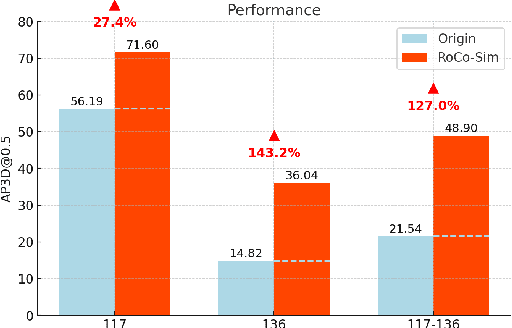
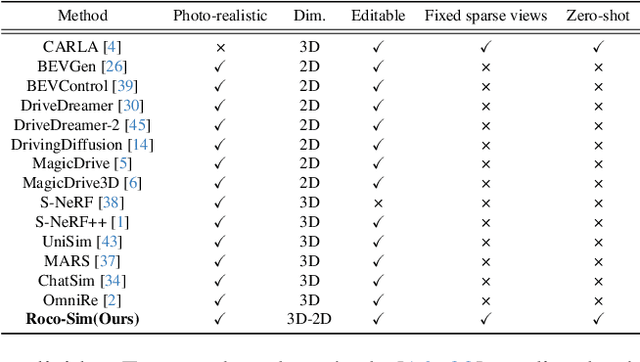
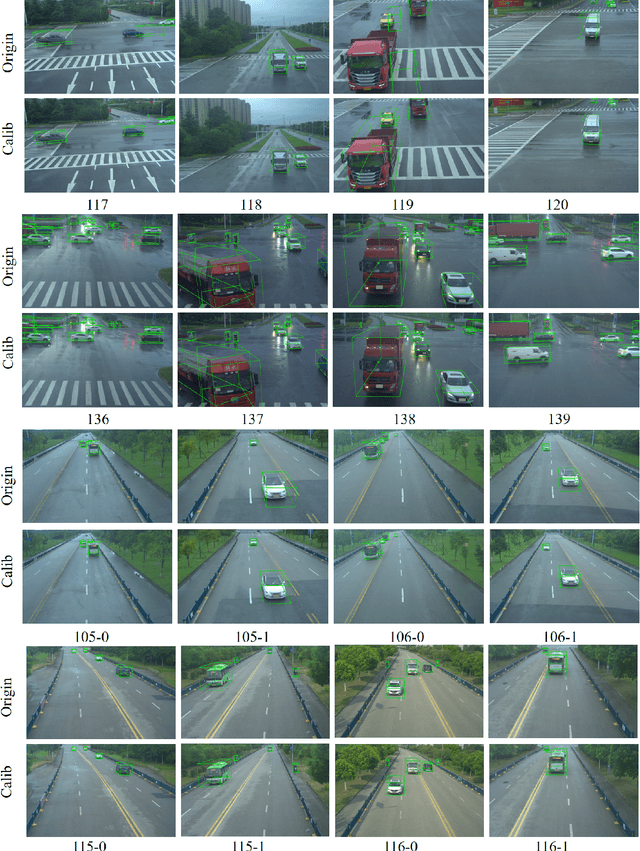
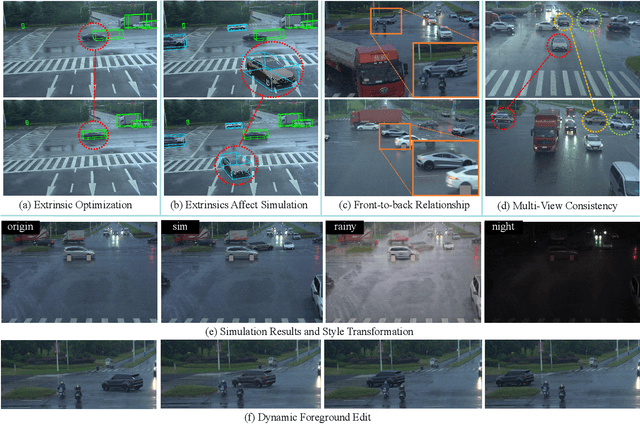
Abstract:Roadside Collaborative Perception refers to a system where multiple roadside units collaborate to pool their perceptual data, assisting vehicles in enhancing their environmental awareness. Existing roadside perception methods concentrate on model design but overlook data issues like calibration errors, sparse information, and multi-view consistency, leading to poor performance on recent published datasets. To significantly enhance roadside collaborative perception and address critical data issues, we present the first simulation framework RoCo-Sim for road-side collaborative perception. RoCo-Sim is capable of generating diverse, multi-view consistent simulated roadside data through dynamic foreground editing and full-scene style transfer of a single image. RoCo-Sim consists of four components: (1) Camera Extrinsic Optimization ensures accurate 3D to 2D projection for roadside cameras; (2) A novel Multi-View Occlusion-Aware Sampler (MOAS) determines the placement of diverse digital assets within 3D space; (3) DepthSAM innovatively models foreground-background relationships from single-frame fixed-view images, ensuring multi-view consistency of foreground; and (4) Scalable Post-Processing Toolkit generates more realistic and enriched scenes through style transfer and other enhancements. RoCo-Sim significantly improves roadside 3D object detection, outperforming SOTA methods by 83.74 on Rcooper-Intersection and 83.12 on TUMTraf-V2X for AP70. RoCo-Sim fills a critical gap in roadside perception simulation. Code and pre-trained models will be released soon: https://github.com/duyuwen-duen/RoCo-Sim
TRCE: Towards Reliable Malicious Concept Erasure in Text-to-Image Diffusion Models
Mar 10, 2025Abstract:Recent advances in text-to-image diffusion models enable photorealistic image generation, but they also risk producing malicious content, such as NSFW images. To mitigate risk, concept erasure methods are studied to facilitate the model to unlearn specific concepts. However, current studies struggle to fully erase malicious concepts implicitly embedded in prompts (e.g., metaphorical expressions or adversarial prompts) while preserving the model's normal generation capability. To address this challenge, our study proposes TRCE, using a two-stage concept erasure strategy to achieve an effective trade-off between reliable erasure and knowledge preservation. Firstly, TRCE starts by erasing the malicious semantics implicitly embedded in textual prompts. By identifying a critical mapping objective(i.e., the [EoT] embedding), we optimize the cross-attention layers to map malicious prompts to contextually similar prompts but with safe concepts. This step prevents the model from being overly influenced by malicious semantics during the denoising process. Following this, considering the deterministic properties of the sampling trajectory of the diffusion model, TRCE further steers the early denoising prediction toward the safe direction and away from the unsafe one through contrastive learning, thus further avoiding the generation of malicious content. Finally, we conduct comprehensive evaluations of TRCE on multiple malicious concept erasure benchmarks, and the results demonstrate its effectiveness in erasing malicious concepts while better preserving the model's original generation ability. The code is available at: http://github.com/ddgoodgood/TRCE. CAUTION: This paper includes model-generated content that may contain offensive material.
Domain Adaptation from Generated Multi-Weather Images for Unsupervised Maritime Object Classification
Jan 26, 2025



Abstract:The classification and recognition of maritime objects are crucial for enhancing maritime safety, monitoring, and intelligent sea environment prediction. However, existing unsupervised methods for maritime object classification often struggle with the long-tail data distributions in both object categories and weather conditions. In this paper, we construct a dataset named AIMO produced by large-scale generative models with diverse weather conditions and balanced object categories, and collect a dataset named RMO with real-world images where long-tail issue exists. We propose a novel domain adaptation approach that leverages AIMO (source domain) to address the problem of limited labeled data, unbalanced distribution and domain shift in RMO (target domain), and enhance the generalization of source features with the Vision-Language Models such as CLIP. Experimental results shows that the proposed method significantly improves the classification accuracy, particularly for samples within rare object categories and weather conditions. Datasets and codes will be publicly available at https://github.com/honoria0204/AIMO.
Towards Deconfounded Image-Text Matching with Causal Inference
Aug 22, 2024
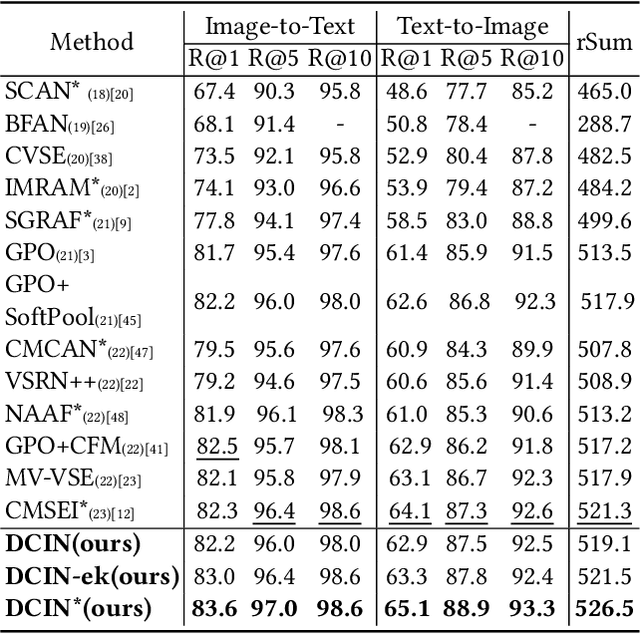
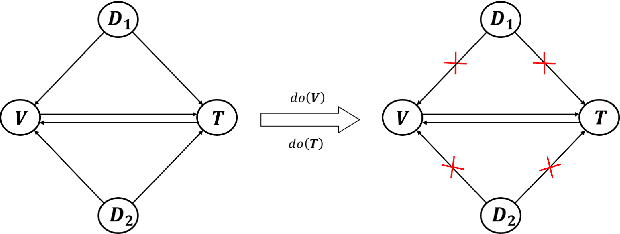
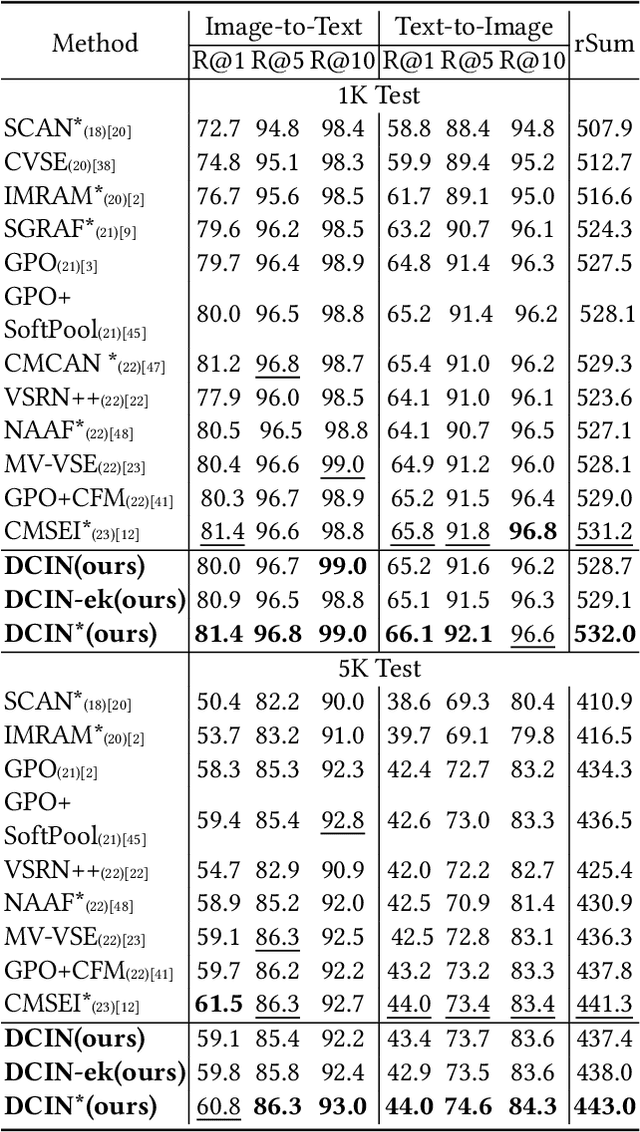
Abstract:Prior image-text matching methods have shown remarkable performance on many benchmark datasets, but most of them overlook the bias in the dataset, which exists in intra-modal and inter-modal, and tend to learn the spurious correlations that extremely degrade the generalization ability of the model. Furthermore, these methods often incorporate biased external knowledge from large-scale datasets as prior knowledge into image-text matching model, which is inevitable to force model further learn biased associations. To address above limitations, this paper firstly utilizes Structural Causal Models (SCMs) to illustrate how intra- and inter-modal confounders damage the image-text matching. Then, we employ backdoor adjustment to propose an innovative Deconfounded Causal Inference Network (DCIN) for image-text matching task. DCIN (1) decomposes the intra- and inter-modal confounders and incorporates them into the encoding stage of visual and textual features, effectively eliminating the spurious correlations during image-text matching, and (2) uses causal inference to mitigate biases of external knowledge. Consequently, the model can learn causality instead of spurious correlations caused by dataset bias. Extensive experiments on two well-known benchmark datasets, i.e., Flickr30K and MSCOCO, demonstrate the superiority of our proposed method.
* ACM MM
A Survey of Datasets for Information Diffusion Tasks
Jul 06, 2024



Abstract:Information diffusion across various new media platforms gradually influences perceptions, decisions, and social behaviors of individual users. In communication studies, the famous Five W's of Communication model (5W Model) has displayed the process of information diffusion clearly. At present, although plenty of studies and corresponding datasets about information diffusion have emerged, a systematic categorization of tasks and an integration of datasets are still lacking. To address this gap, we survey a systematic taxonomy of information diffusion tasks and datasets based on the "5W Model" framework. We first categorize the information diffusion tasks into ten subtasks with definitions and datasets analysis, from three main tasks of information diffusion prediction, social bot detection, and misinformation detection. We also collect the publicly available dataset repository of information diffusion tasks with the available links and compare them based on six attributes affiliated to users and content: user information, social network, bot label, propagation content, propagation network, and veracity label. In addition, we discuss the limitations and future directions of current datasets and research topics to advance the future development of information diffusion. The dataset repository can be accessed at our website https://github.com/fuxiaG/Information-Diffusion-Datasets.
A Training-Free Plug-and-Play Watermark Framework for Stable Diffusion
Apr 08, 2024



Abstract:Nowadays, the family of Stable Diffusion (SD) models has gained prominence for its high quality outputs and scalability. This has also raised security concerns on social media, as malicious users can create and disseminate harmful content. Existing approaches involve training components or entire SDs to embed a watermark in generated images for traceability and responsibility attribution. However, in the era of AI-generated content (AIGC), the rapid iteration of SDs renders retraining with watermark models costly. To address this, we propose a training-free plug-and-play watermark framework for SDs. Without modifying any components of SDs, we embed diverse watermarks in the latent space, adapting to the denoising process. Our experimental findings reveal that our method effectively harmonizes image quality and watermark invisibility. Furthermore, it performs robustly under various attacks. We also have validated that our method is generalized to multiple versions of SDs, even without retraining the watermark model.
Impart: An Imperceptible and Effective Label-Specific Backdoor Attack
Mar 18, 2024Abstract:Backdoor attacks have been shown to impose severe threats to real security-critical scenarios. Although previous works can achieve high attack success rates, they either require access to victim models which may significantly reduce their threats in practice, or perform visually noticeable in stealthiness. Besides, there is still room to improve the attack success rates in the scenario that different poisoned samples may have different target labels (a.k.a., the all-to-all setting). In this study, we propose a novel imperceptible backdoor attack framework, named Impart, in the scenario where the attacker has no access to the victim model. Specifically, in order to enhance the attack capability of the all-to-all setting, we first propose a label-specific attack. Different from previous works which try to find an imperceptible pattern and add it to the source image as the poisoned image, we then propose to generate perturbations that align with the target label in the image feature by a surrogate model. In this way, the generated poisoned images are attached with knowledge about the target class, which significantly enhances the attack capability.
Revealing Vulnerabilities in Stable Diffusion via Targeted Attacks
Jan 16, 2024Abstract:Recent developments in text-to-image models, particularly Stable Diffusion, have marked significant achievements in various applications. With these advancements, there are growing safety concerns about the vulnerability of the model that malicious entities exploit to generate targeted harmful images. However, the existing methods in the vulnerability of the model mainly evaluate the alignment between the prompt and generated images, but fall short in revealing the vulnerability associated with targeted image generation. In this study, we formulate the problem of targeted adversarial attack on Stable Diffusion and propose a framework to generate adversarial prompts. Specifically, we design a gradient-based embedding optimization method to craft reliable adversarial prompts that guide stable diffusion to generate specific images. Furthermore, after obtaining successful adversarial prompts, we reveal the mechanisms that cause the vulnerability of the model. Extensive experiments on two targeted attack tasks demonstrate the effectiveness of our method in targeted attacks. The code can be obtained in https://github.com/datar001/Revealing-Vulnerabilities-in-Stable-Diffusion-via-Targeted-Attacks.
 Add to Chrome
Add to Chrome Add to Firefox
Add to Firefox Add to Edge
Add to Edge